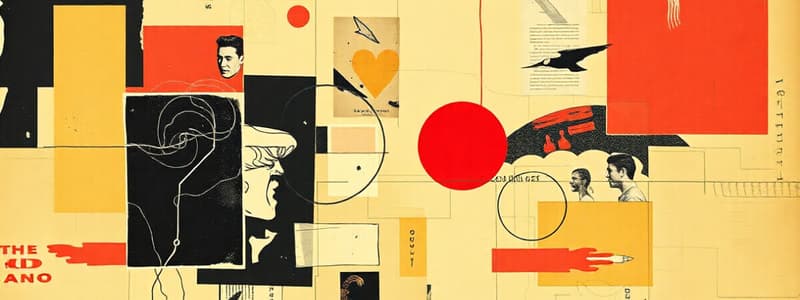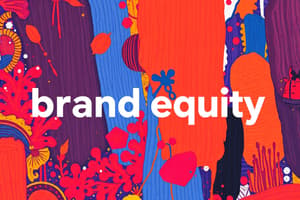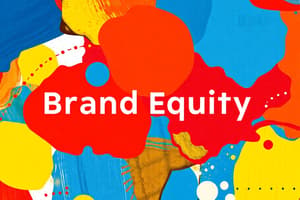Podcast
Questions and Answers
What encompasses the entire image and personality of a brand?
What encompasses the entire image and personality of a brand?
- Values, tone, and emotional connections (correct)
- Competitive pricing
- Logo and name only
- Customer feedback
Which approach to branding focuses on the relationship between the marketer and an active consumer?
Which approach to branding focuses on the relationship between the marketer and an active consumer?
- Constructivist/interpretive approach (correct)
- Sensory approach
- Economic approach
- Identity approach
What was the initial perspective on branding during its evolution?
What was the initial perspective on branding during its evolution?
- Emotion-focused perspective
- Human-centered perspective
- Company's perspective (correct)
- Consumer-based approach
How has the focus of branding shifted over time?
How has the focus of branding shifted over time?
What defines the positivistic brand management paradigm?
What defines the positivistic brand management paradigm?
Which type of branding approach acknowledges the chaotic forces in consumer culture?
Which type of branding approach acknowledges the chaotic forces in consumer culture?
What is a primary characteristic of brand equity in the constructivist paradigm?
What is a primary characteristic of brand equity in the constructivist paradigm?
What major shift occurred in methods of brand value creation?
What major shift occurred in methods of brand value creation?
What distinguishes private-label products from generic items?
What distinguishes private-label products from generic items?
Which strategy is most commonly used by retailers to enhance private-label product appeal?
Which strategy is most commonly used by retailers to enhance private-label product appeal?
How do retailers typically categorize their private-label brands?
How do retailers typically categorize their private-label brands?
What assumption does the concept of 'the economic man' rely on regarding consumer behavior?
What assumption does the concept of 'the economic man' rely on regarding consumer behavior?
Why is continuous product development important for private-label brands?
Why is continuous product development important for private-label brands?
What is a key factor that influences consumer purchasing decisions according to rational consumption choices?
What is a key factor that influences consumer purchasing decisions according to rational consumption choices?
What does the concept of 'the invisible hand' suggest about resource allocation?
What does the concept of 'the invisible hand' suggest about resource allocation?
What is a potential outcome of retailers effectively managing their private label brand?
What is a potential outcome of retailers effectively managing their private label brand?
What is a key characteristic of heritage brands?
What is a key characteristic of heritage brands?
Which trait indicates a heritage brand's ability to connect different time periods?
Which trait indicates a heritage brand's ability to connect different time periods?
What does the concept of corporate identity primarily focus on?
What does the concept of corporate identity primarily focus on?
In the context of brand-consumer exchange, how is reputation best described?
In the context of brand-consumer exchange, how is reputation best described?
What does 'claimed distinctiveness' refer to in organisational identity?
What does 'claimed distinctiveness' refer to in organisational identity?
What does augmented role identities imply for corporate heritage institutions?
What does augmented role identities imply for corporate heritage institutions?
Which of the following is NOT a characteristic of effective heritage brand management?
Which of the following is NOT a characteristic of effective heritage brand management?
How has the perception of brand identity evolved?
How has the perception of brand identity evolved?
What is a primary driver of brand attitudes and consumer choices?
What is a primary driver of brand attitudes and consumer choices?
How does adopting a broad view of marketing decisions impact brand loyalty?
How does adopting a broad view of marketing decisions impact brand loyalty?
What is the significance of self-congruity in brand perception?
What is the significance of self-congruity in brand perception?
Which of the following best describes the concept of brand personality?
Which of the following best describes the concept of brand personality?
What role do tracking studies play in marketing decisions?
What role do tracking studies play in marketing decisions?
What assumption is made about consumers regarding brand personality?
What assumption is made about consumers regarding brand personality?
Which guideline encourages evaluating potential extension candidates?
Which guideline encourages evaluating potential extension candidates?
Why do consumers view material possessions as part of their identity?
Why do consumers view material possessions as part of their identity?
What is a doppelgänger brand?
What is a doppelgänger brand?
What is the primary focus of the consumer-based brand equity approach?
What is the primary focus of the consumer-based brand equity approach?
What does the term 'citizen-artist brand' refer to?
What does the term 'citizen-artist brand' refer to?
What led to the paradigm shift in branding according to the content?
What led to the paradigm shift in branding according to the content?
Which of the following is NOT a step in aligning identity gaps?
Which of the following is NOT a step in aligning identity gaps?
What challenges do brands face from the changing consumer culture?
What challenges do brands face from the changing consumer culture?
What metaphor is used to describe the consumer's processing of brand information in a linear communication model?
What metaphor is used to describe the consumer's processing of brand information in a linear communication model?
Which of the following is a characteristic of post-postmodern branding?
Which of the following is a characteristic of post-postmodern branding?
How can organizations effectively engage stakeholders according to the framework for identity gaps?
How can organizations effectively engage stakeholders according to the framework for identity gaps?
How should brands manage touchpoints according to the content?
How should brands manage touchpoints according to the content?
What assumption is made about the consumer in the brand-consumer exchange model?
What assumption is made about the consumer in the brand-consumer exchange model?
What is the consequence of manipulating human desires through advertising?
What is the consequence of manipulating human desires through advertising?
What role do activities and events play in the context of corporate branding?
What role do activities and events play in the context of corporate branding?
Which of the following is a key aspect of integrating culture and images around a new brand identity?
Which of the following is a key aspect of integrating culture and images around a new brand identity?
What is a notable theme discussed in 'No Logo'?
What is a notable theme discussed in 'No Logo'?
What paradox is presented regarding consumer ownership of the brand?
What paradox is presented regarding consumer ownership of the brand?
Flashcards
What is branding?
What is branding?
Branding encompasses more than just a logo or name. It encompasses the brand's overall image, personality, values, tone, and the emotional connection it forms with its audience.
What is brand equity?
What is brand equity?
A brand's equity is its value in the minds of consumers. It's the perception of a company or product that influences their choices and loyalty.
What is the Positivistic brand management paradigm?
What is the Positivistic brand management paradigm?
In the Positivistic paradigm, brands are seen as tools controlled by marketers to influence passive consumers. They are essentially 'owned' by the company and used to create a predetermined image.
What is the Constructivist/Interpretive brand management paradigm?
What is the Constructivist/Interpretive brand management paradigm?
Signup and view all the flashcards
What is the early brand management approach?
What is the early brand management approach?
Signup and view all the flashcards
What is the consumer-based brand management approach?
What is the consumer-based brand management approach?
Signup and view all the flashcards
What is the Sensory brand management approach?
What is the Sensory brand management approach?
Signup and view all the flashcards
How has brand value creation shifted?
How has brand value creation shifted?
Signup and view all the flashcards
What defines a heritage brand?
What defines a heritage brand?
Signup and view all the flashcards
Institutional trait consistency
Institutional trait consistency
Signup and view all the flashcards
Tri-generational hereditary
Tri-generational hereditary
Signup and view all the flashcards
What is a private-label product?
What is a private-label product?
Signup and view all the flashcards
Augmented role identities
Augmented role identities
Signup and view all the flashcards
Ceaseless multigenerational stakeholder utility
Ceaseless multigenerational stakeholder utility
Signup and view all the flashcards
How do retailers build their private label brands?
How do retailers build their private label brands?
Signup and view all the flashcards
What is the 'economic man'?
What is the 'economic man'?
Signup and view all the flashcards
Corporate identity (visual and strategic pov)
Corporate identity (visual and strategic pov)
Signup and view all the flashcards
What is 'perfect information'?
What is 'perfect information'?
Signup and view all the flashcards
Organizational identity
Organizational identity
Signup and view all the flashcards
Reputation
Reputation
Signup and view all the flashcards
Is 'perfect information' a realistic assumption?
Is 'perfect information' a realistic assumption?
Signup and view all the flashcards
What is the 'invisible hand' theory?
What is the 'invisible hand' theory?
Signup and view all the flashcards
How are consumers perceived in traditional marketing?
How are consumers perceived in traditional marketing?
Signup and view all the flashcards
Is the passive consumer assumption still relevant?
Is the passive consumer assumption still relevant?
Signup and view all the flashcards
Detecting Identity Gaps
Detecting Identity Gaps
Signup and view all the flashcards
Aligning Identity Gaps
Aligning Identity Gaps
Signup and view all the flashcards
Stating (Aligning Identity Gaps)
Stating (Aligning Identity Gaps)
Signup and view all the flashcards
Organizing (Aligning Identity Gaps)
Organizing (Aligning Identity Gaps)
Signup and view all the flashcards
Involving (Aligning Identity Gaps)
Involving (Aligning Identity Gaps)
Signup and view all the flashcards
Integrating (Aligning Identity Gaps)
Integrating (Aligning Identity Gaps)
Signup and view all the flashcards
Monitoring (Aligning Identity Gaps)
Monitoring (Aligning Identity Gaps)
Signup and view all the flashcards
Customer-Based Brand Equity
Customer-Based Brand Equity
Signup and view all the flashcards
Symbolic Brand Benefits
Symbolic Brand Benefits
Signup and view all the flashcards
Brand Personality
Brand Personality
Signup and view all the flashcards
Self-Congruity
Self-Congruity
Signup and view all the flashcards
Brand Consumer Exchange
Brand Consumer Exchange
Signup and view all the flashcards
Big Five in Brand Management
Big Five in Brand Management
Signup and view all the flashcards
Material Possessions as Extended Self
Material Possessions as Extended Self
Signup and view all the flashcards
Homogeneous Brand Personality Perception
Homogeneous Brand Personality Perception
Signup and view all the flashcards
Consumer Perception & Brand Positioning
Consumer Perception & Brand Positioning
Signup and view all the flashcards
What are brand touchpoints?
What are brand touchpoints?
Signup and view all the flashcards
Why and how can brands manage touchpoints?
Why and how can brands manage touchpoints?
Signup and view all the flashcards
What are the fundamental components of a sensory identity?
What are the fundamental components of a sensory identity?
Signup and view all the flashcards
Doppelgänger brand
Doppelgänger brand
Signup and view all the flashcards
No Logo
No Logo
Signup and view all the flashcards
Citizen-artist brand
Citizen-artist brand
Signup and view all the flashcards
Post-postmodern branding
Post-postmodern branding
Signup and view all the flashcards
The paradigm shift in branding
The paradigm shift in branding
Signup and view all the flashcards
Study Notes
Brand Management Assignments - Table of Contents
- Tutorial 1: Introduction (pages 2, 42)
- Tutorial 2: Economic Approach (pages 4, 5)
- Tutorial 3: Identity Approach (pages 8, 9, 10, 11)
- Tutorial 4: Consumer-based Approach (pages 15, 16, 17, 18)
- Tutorial 6: Personality Approach (pages 19, 20, 21)
- Tutorial 6: Relational Approach (pages 24, 26, 27, 28)
- Tutorial 7: Community Approach (pages 29, 30, 31, 32)
- Tutorial 8: Cultural Approach (page 35)
- Tutorial 9: Sensory Approach (pages 41, 42, 43, 44, 45, 46)
Studying That Suits You
Use AI to generate personalized quizzes and flashcards to suit your learning preferences.




